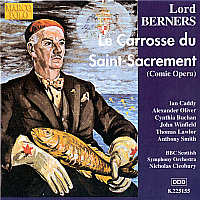LORD BERNERS (1883-1950)
Le Carrosse du Saint-Sacrement (1923)
Fanfare (1931)
Caprice Péruvien
(1938)
 Viceroy: Ian Caddy (bar)
Martinez: Alexander Oliver (ten) Balthasar: John Winfield (ten)
La Périchole: Cynthia Buchan (sop) Thomas d'Esquivel:
Thomas Lawlor (bass) Bishop of Lima: Anthony Smith
(bass)
Viceroy: Ian Caddy (bar)
Martinez: Alexander Oliver (ten) Balthasar: John Winfield (ten)
La Périchole: Cynthia Buchan (sop) Thomas d'Esquivel:
Thomas Lawlor (bass) Bishop of Lima: Anthony Smith
(bass)
BBC Scottish SO/Nicholas Cleobury (Carrosse)
rec Glasgow 16 Aug 1983
Royal Ballet Sinfonia/Gavin Sutherland (Fanfare)
rec London 15 Sept 1999
RTE Sinfonietta/David Lloyd-Jones (Caprice)
rec Dublin 10 Jan 1995
 MARCO POLO 8.225155
[79.17]
MARCO POLO 8.225155
[79.17]
Crotchet

Berners the eccentric; Berners the eclectic; Berners the wit. None of these
headline reputations should blind us to his way with melody or with brilliance.
Derivative he may be but he was a bright musical conversationalist with ideas
in his head and the 'apparatus' to articulate them.
The opera (Berners' only one) is set in Lima in the office of the Viceroy.
It follows the play by Prosper Mérimée. The plot is
inconsequential. By the way, the 'Carrosse' is La Périchole's brand
new carriage which at the climax of the opera she donates to the Church to
bring communion to the sick and dying. This is a busy score teeming with
brilliant instrumental activity though not with stunning melody (though it
has its moments). Lyrical heart is exposed at 18.33 in Track 6 and at 1.55
(Track 10) amid the bath of spiritual ecstasy as La Périchole announces
the gift of the carriage. That said, the singing is generally unshackled
from the instrumental line. The music has the swoon of Rosenkavalier
with Spanish spit and crackle mingling with opulence. The recording (derived
from broadcast tapes I have known since the first broadcast in 1983) is quite
forward but natural sounding. It is well acted and pronunciation is clear
without being studied; chuckling with vivacity and a proud yet graceful
heartiness (as Scene 4 demonstrates). The work ends as abruptly as it started.
La Carrosse would be well teamed with Holst's Wandering Scholar
or Perfect Fool, Barber's A Hand of Bridge or Vaughan Williams'
Poisoned Kiss (now when will we get a recording of that work?). All
texts are sung and printed in English.
The Caprice Péruvien was constructed by Berners as a joint
effort with Constant Lambert out of thematic material from the opera. Much
of the music comes from scene 6 in which the Viceroy takes coffee and cigars.
As Philip Lane says, in the detailed notes, the Caprice can form a
prelude to the opera which itself has no overture and otherwise dives straight
into the action (as Berners truculently intended). The Caprice is
cross-cut with familiar voices and accents: Goossens' brilliance, de Falla's
Three-Cornered Hat, Bax's Mediterranean, Ravel's Rhapsodie
Espagnole and even Copland's El Salon Mexico. The RTE Sinfonietta
do not have quite the splinter-sharp accuracy called for but it still registers
well. A 1980s broadcast by the English Chamber Orchestra conducted by Philip
Ledger and a 1992 broadcast by Barry Wordsworth conducting the much
under-estimated BBC Concert Orchestra show that a tighter approach reaps
a more bristling harvest. The fanfare is tangy and regal and rings out with
conviction.
A very generous disc enjoyable by anyone who is already well attuned to the
briskly cosmopolitan language of the 1920s and 1930s. This music has a richer
emotional core than you might expect.
Rob Barnett


